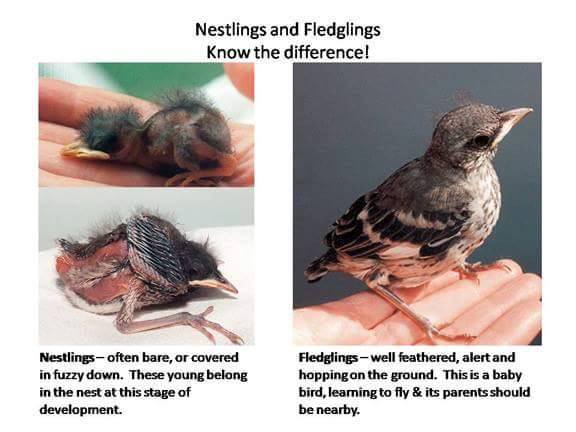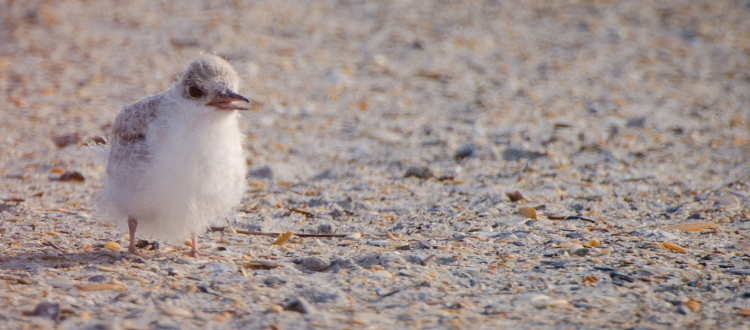Found a Baby Bird?
April through August is considered baby bird season at SkyWatch, and during this time we receive a huge influx of young birds. In order to prevent birds being “stolen” from their homes, it’s important to know the difference between a true baby bird and a fledgling bird. Baby birds found on the ground need help. Fledgling birds in most cases do not need help and have a right to be on the ground. When you find a (healthy and uninjured) fledgling bird, you have to leave it alone by law. There are however certain circumstances when you need to intervene. Read this full article to determine what to do.
Here’s how it goes:
Baby birds grow and turn into fledglings.
Finding Food
Mistaken Identity


What to do if you find a baby bird:
Just because you come across a baby bird in your backyard, driveway, on the side of the road or in a parking lot does not mean you can take the baby bird or that it necessarily needs help. See below for instructions on when you should take the bird and what to do with baby and fledgling birds.When should I take the bird?
The ONLY time you should intervene and take a baby bird is:
– You see obvious injuries (seeing blood and/or bone)
– If the bird has been in contact with a cat or dog in ANY way.
– Even if you don’t see injury – if a cat touched it, the bird needs medication
– If you have visual confirmation that the mother bird is dead.
– If it’s a true baby bird, not a fledgling
(see description and pictures of what a baby looks like)
– If the bird is in a dangerous place and can’t be moved to nearby bushes or a safer spot
– If the baby has flies all over it or is laying on its side
– If it’s a baby and the nest has been completely destroyed
– If you can’t reach the nest to put the baby back in the nest.
Remember: There is a difference between BABY birds and FLEDGLING birds. You should never take a fledgling bird unless it truly needs help.
I know what I found is truly a baby bird, now what?
First: If you know where the nest is and can reach it, simply put the baby back in the nest. It’s ok to pick up a baby bird with your bare hands and put it back in the nest right away.
Next: Clear the area and observe from a distance for 20 continuous minutes. If there is no activity from an adult bird within half hour, it’s safe to assume the mom can’t come back or is dead.
If you found a baby whose nest has been destroyed:
You must right away put the baby bird in a small bowl lined with soft tissue or toilet paper. Cover the bowl with a small towel so they are snug and warm like in a little cave.
Keep the babies warm and dark and quiet.
DO NOT drip any liquids down the throat. This may work for mammals but you are actually causing the baby bird to aspirate or inhale the water into their lungs. Babies don’t drink water – they get all their fluids from the food they eat.
Don’t let children pet or play with the babies. Remember, you are trying to save their lives – they are not toys for entertainment
Don’t let your cat or dog sit and stare at or sniff the baby
Don’t put the baby in a big box surrounded by lots of empty space. Remember, the nests they grow up in are snug and cuddled.
Don’t lift the towel and check on them too frequently. Every time you uncover them, you let the cold air in and compromise their temperature.
Don’t talk too loud over the baby. To them we are like giants and our voices are really loud.
In some cases the baby might be “gaping.” Gaping is when they stretch their necks out into the air vigorously and open their mouths really wide dlouhygaragedoorrepair.com. Gaping is an automatic response for them, that’s how they ask for food in the nest.
If they are gaping you can give SMALL bits of fruit like strawberries or dry cat food softened in a small bit of water and gently place it in their mouths with tweezers one bit at a time until they stop gaping. This is only a temporary fix, not a permanent diet.
DO NOT give any bird bread. Bread has no nutritional value for them.
Bring the baby to SkyWatch as soon as possible, especially if the baby has not eaten anything in over half an hour. Babies have to be properly hydrated and fed every 20- 45 minutes 14 hours a day and in some cases need to be hydrated intravenously right away.
In the meantime keep the baby warm and dark and quiet. Baby birds must feel WARM to the touch.
Looks like I found a fledgling, now what?
If you find a fledgling in your backyard or a dangerous spot like in the road or in the middle of a parking lot, pick the bird up (you can use your bare hands) and take the bird over the nearest bush or shrub and place it in a shady spot.
The mommy bird will be back soon and will find the baby. The mommy may already be back, but she won’t approach her baby while people are nearby. She is sitting nearby waiting for the people to leave. Remember, birds don’t know you are trying to help and to them we are the same as predators.
If the bird sits by itself without any parent coming by for a full 40 minutes, then you can go back and take the bird but you can only be sure if you can continuously observe the bird without looking away for a minute.
Remember, it only takes a few seconds for the mom to come down and pop some food in the baby’s mouth and fly off again, so you may miss it and think that the bird is still alone. If you have cats or dogs, try to keep them away from that area for the next few days.
If they must come in, follow the instructions above on how to handle a baby bird.

